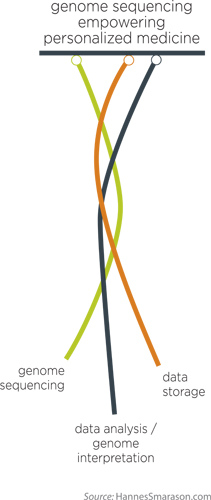
Lower-cost genome sequencing, genomic analysis tools, and reference databases for human genomes are the “3-legged stool” that will help the world reach personalized medicine.
Genome sequencing technology available today can accurately sequence a whole genome from an individual’s test sample for a surprisingly low cost—a few thousand dollars (and dropping fast). As a result, the adoption of this technology is rapidly expanding as medical centers around the world embrace its utility in informing healthcare decisions—an emerging reality of personalized medicine.
Three important areas of technology progress have enabled the medical community to reach this point:
- Lower-Cost Genome Sequencing: Major technological advances have reduced the cost of sequencing to nearly $1,000 or less, a critical milestone to enable the use of sequencing as a mass-market product for medical care.
- Genomic Analysis Tools: Since the human genome was first sequenced more than a decade ago, an increasingly robust body of research has showcased the links between mutations identified in the genome and disease risk. Informatics tools have been developed by medical centers and genomics companies to apply to whole-genome samples. Increasingly, these genome analysis tools will need to adapt to the steady pace of new genomic linkages to disease and to operate at a level approaching “big data.”
- Reference Databases for Human Genomes: There are a growing number of robust databases of human genomes, including data for healthy people or those with certain diseases. When properly analyzed, these databases offer the potential to provide the medical community with a reference library against which to compare genetic data. Large-scale, high-quality databases are an essential element to cross-reference a patient genome to guide more informed medical decisions.
These three technology domains represent the “3-legged stool” that will help the world reach personalized medicine. The technology is in place, and the corresponding insights and uses are expanding every day. Yet there are challenges to be resolved before implementing these tools on a universal basis.
For example, logistically, how will new DNA and supercomputing equipment be accessed by medical centers, and how will the data be stored? And more importantly, what is the most efficient way to compare an individual’s genome to the massive body of genomic information available to help inform medical decisions for that patient?
One important part of the solution: we must turn to “big data” solutions to manage and make use of the enormous amounts of data produced through sequencing. The whole-genome sequence of a single human is roughly 100GB—that’s the entire storage capacity of a single Macbook Air®.
The progress to date has been amazing. Yet the opportunities ahead are even more extraordinary to improve the speed, accuracy, and accessibility of genomic information to improve human health.
